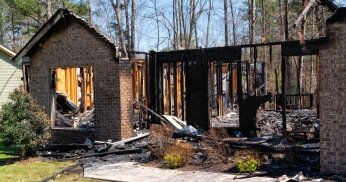 Home Insurance
Home InsuranceWill a GoFundMe gift affect your home insurance claim payout?
This article has been updated from a previous version. When families face unexpected tragedies, crowdfundi...

Compare the lowest Alberta home insurance rates, save up to 36%.*
Get 50+ quotes in 3 minutes.
Compare Alberta home insurance quotes from top home insurance providers

Unlike auto insurance, home insurance isn’t a mandatory product. That said, if you want to secure a mortgage, almost every lender is going to require proof of home insurance before they approve you.
And so you might be wondering: how much will home insurance cost me? The truth is: there’s no one-size-fits-all answer. There are several factors insurance companies take into account when figuring out your premiums.
But instead of searching for a home insurance calculator in Alberta, Canada, which may give you a rough estimate of your homeowners insurance costs in Alberta but won’t be as accurate as one that captures these details, we suggest using our home insurance quoter. This no-obligation tool asks all the relevant questions and then compares the home insurance market for you — for free — and presents you with the lowest rates from multiple insurance providers in Alberta. By using LowestRates.ca’s Alberta home insurance calculator, your annual insurance bill could be reduced by hundreds of dollars.
Now let’s get you informed of what home insurance does and doesn’t cover, as well as the different types of coverage you might need if you live in Alberta.
See how our customers save big on home insurance in Alberta
| Type of home | Location | Previous claims | Lowest rate | Average rate | Saved |
|---|---|---|---|---|---|
Quote from July 02, 2025 Type of home Triplex 1,728 sq ft | Location Calgary | Previous claims None | Lowest Rate $178/mth $2,134/yr | Average rate $254/mth $3,048/yr | Saved $76/mth $912/yr (30.00%) |
Quote from July 03, 2025 Type of home Townhouse 2,630 sq ft | Location EDMONTON | Previous claims None | Lowest Rate $302/mth $3,627/yr | Average rate $411/mth $4,933/yr | Saved $109/mth $1,308/yr (26.00%) |
Quote from July 02, 2025 Type of home Detached 1,001 sq ft | Location Calgary | Previous claims None | Lowest Rate $175/mth $2,094/yr | Average rate $208/mth $2,498/yr | Saved $34/mth $408/yr (16.00%) |
One of the best ways to find the cheapest Alberta Home insurance is to educate yourself about costs using our handy insurance calculator. It’s easy and free to use. It only takes three minutes if you follow these steps.
There are four types of coverage for home insurance in Alberta:
Comprehensive - The highest level of coverage you can purchase. It insures the building and its contents against all risks, except for ones that are specifically excluded.
Broad - Offers coverage for building and some of its contents.
Basic - Only provides coverage for some perils.
No-Frills - Offers basic coverage for properties that are hard to insure (e.g., homes that have numerous structural issues).
Forest fires are covered by home insurance policies, and that also covers some expenses you might incur if you’re ever forced to evacuate your home. You may need to purchase additional insurance coverage, called an endorsement, for overland flooding. Endorsements for flooding were once difficult to purchase, but insurers are beginning to offer it.
Your monthly home insurance payments will be based largely on how much coverage you purchase. But there are other things that play into your payment.
This is the primary factor insurance companies use to determine your home insurance payments. How much home insurance you buy will depend on the type of policy you’re after. For example, do you require a run-of-the-mill policy that covers the basics, or do you need something a little more comprehensive? Perhaps you have high-value items in your home, like jewelry and artwork, that you need to purchase additional coverage for. Or you live in an area prone to extreme weather and require things like overland flood coverage.
This is a big one for insurance companies. If your home is damaged or destroyed by inclement weather or some sort of accident, your insurance company is going to be on the hook — either fully or partially — for the cost to repair or replace it.
What’s inside your home is also a major factor in determining your insurance premiums. Policies will often carry a dollar limit for replacement of your home’s contents. If the items you have inside your home exceeds that dollar amount, you may want to consider buying additional coverage.
In addition to the factors that go into calculating your home insurance premiums, the items below may also come into play.
What you pay for home insurance may also vary depending on which lender you decide to go with. Some lenders may require you to buy additional coverage, for instance, which translates into higher premiums. This is why it’s in your best interest to compare the market using price comparison websites like LowestRates.ca.
If you don’t pay your premiums on time each month or year, you may be charged additional fees. That’s why it’s crucial to make sure, for example, that your credit card isn’t going to expire before you sign up with your new insurance company. This would likely result in a late payment fee. If you accumulate too many of those, your insurance company may cancel your policy. It’s also important to consider monthly interest when calculating your home insurance costs.
Location matters to insurance companies when determining your insurance rates. If, for example, you live in a high-crime neighbourhood, you might face higher rates. Or if you live in a more affluent neighbourhood, where home prices are higher, you could also face higher rates. To find out how this will have an impact on what you pay monthly, use our home insurance calculator for Alberta.
Living close to a fire station might mean being woken up in the middle of the night, but it could also lead to lower premiums because there’s a reduced chance of substantial property damage. The opposite is true, too, especially in rural or remote areas, where homeowners could face higher rates for living farther from a fire station or hydrant.
Just like we age, so do our homes. And over time, they become more susceptible to damage. If you make upgrades and repairs to your home to avoid damage from old leaking pipes, for instance, or a deteriorating roof, this could help lower your premiums. This is why newly built homes tend to come with lower insurance rates.
If you work from home or run a home-based business, you could pay more for home insurance because there are additional items that would need to be insured, such as a laptop. If you’ve decided to rent out your home, then you will need liability insurance to protect yourself from being sued if someone is injured on your property. This coverage can increase your premiums.
When insurance companies are figuring out what to charge you, they want to know if you have a history of making frequent home insurance claims. If you do, this will likely increase your premiums, since you then appear more “risky” to the insurance provider.
Why does age matter when it comes to protecting your home? Because as you get older, you may have a harder time maintaining your property. This leaves the potential for accidents to happen, either in the home, or on the property, and as a result, you may face higher premiums.
The way your house is heated also has an impact on your premiums. If, for instance, your primary source of heating is oil, you might pay more for home insurance because oil heating systems are riskier than a gas furnace or electric heating system since there’s the chance of leaks. Similarly, if you have a wood stove instead of a gas stove, your insurance provider might charge you a higher premium because there’s an increased risk of fire or carbon monoxide poisoning.
Other factors that can influence your home insurance rates are:
Because your insurance premiums reflect how risky your home is to insure, one of the best ways you can bring down your rates is to make your home safer and less prone to damage. Here are a few ways to do just that:
Having a monitored burglar alarm or fire alarm system signals to insurance companies that you’ve taken steps to reduce your risk of theft and of fire, which can in turn reduce your premiums.
Installing a backflow valve or a sump pump can also result in lower premiums.
Another way to save on home insurance is to upgrade your roof using materials that prevent weather-related damage, such as class four asphalt shingles or slate tiles.
Perhaps the easiest and most common way to save on insurance is to bundle your auto and home insurance with the same insurance provider. We encourage you to reach out to your insurance company and get a quote for bundling both forms of insurance. You’ll be surprised by how much you can save.
When you agree to pay a higher deductible, which refers to the amount of money you’ll have to pay out of pocket when you make a claim, you’ll benefit from lower premiums.
It’s not that doing this will result in you paying more for insurance, but you might have to pay a penalty for ending your policy before it renews.
This is an easy and free way to save money. Simply ask your insurance company about potential discounts and find out what you qualify for.
If you make multiple claims with your insurance company, they might see you as a higher-risk customer to insure, and as such, will raise your premiums.
Your questions about calculating Alberta home insurance cost, answered.
Looking for more info about your Alberta home insurance cost? Check out our Home Insurance Buying Guide or the Help Centre.
Not really. The only thing that might change is the types of “endorsements” or “add-ons” that you can purchase for your policy. For example, you might be able to purchase earthquake coverage in Ontario for less than you would in, say, British Columbia, where the risk of an earthquake is higher.
In addition, if you live in a hot housing market where home prices are high, you may notice you pay higher home insurance premiums than somewhere else.
You can purchase home insurance a few different ways. You can buy through a licensed insurance broker in Alberta, via an insurance agent or company, or you can go online and shop different companies. For example, you can compare homeowners insurance rates in Alberta with the calculator provided by LowestRates.ca. We refer to this as our “quoter” because it provides you with the best (see: lowest) home insurance quotes from actual Alberta home insurance providers. All you need to do is provide some information about your home, and our quoter will generate several competitive rates from the top home insurance providers in the area. If you select one, a broker or agent will be in touch to secure this rate for you.
Because your insurance premiums reflect how risky your home is to insure, one of the best ways you can bring down your rates is to make your home safer and less prone to damage. Here are a few ways to do just that:
Install security and safety features: Having a monitored burglar alarm or fire alarm system signals to insurance companies that you’ve taken steps to reduce your risk of theft and of fire, which can in turn reduce your premiums.
Take measures to prevent water damage: Installing a backflow valve or a sump pump can also result in lower premiums.
Build your roof with weather-resistant materials: Another way to save on home insurance is to upgrade your roof using materials that prevent weather-related damage, such as class four asphalt shingles or slate tiles.
Bundle your home and auto insurance policies: Perhaps the easiest and most common way to save on insurance is to bundle your auto and home insurance with the same insurance provider. We encourage you to reach out to your insurance company and get a quote for bundling both forms of insurance. You’ll be surprised by how much you can save.
Increase your deductible: When you agree to pay a higher deductible, which refers to the amount of money you’ll have to pay out of pocket when you make a claim, you’ll benefit from lower premiums.
Don’t switch insurance companies in the middle of your policy term: It’s not that doing this will result in you paying more for insurance, but you might have to pay a penalty for ending your policy before it renews.
Inquire about discounts: This is an easy and free way to save money. Simply ask your insurance company about potential discounts and find out what you qualify for.
Don’t make too many claims: If you make multiple claims with your insurance company, they might see you as a higher-risk customer to insure, and as such, will raise your premiums.
You’re in luck! On LowestRates.ca, you can purchase property insurance regardless of whether you’re buying a home, buying a condo or renting. If you’re looking for more information about either of these products, feel free to visit either our dedicated Condo Insurance or Renters Insurance pages.
Premiums are the monthly or annual payments you make in order to maintain your insurance policy. When you fill out a form to compare Alberta house insurance rates with our calculator tool, you’ll see both the premiums that the insurance companies are willing to offer based on the information you provide.
Some people pay their premiums in a lump sum once a year; others pay it monthly. This will largely depend on the lender and what they prefer. Sometimes, if your home insurance is under a certain annual amount, you may not have the option to pay monthly and you may have to pay in a lump sum. But typically, payments can be made annually, biweekly, or even monthly. Our Alberta home insurance quoter will show you both the annual amount and the monthly amount, but it won’t dictate how you’re going to pay. A broker or agent will get in touch with you shortly after you complete the form to secure that rate and at that time, you can discuss payment frequency.
If your Alberta home insurance policy covers the actual cash value of an item that is lost or damaged, the amount you’ll be paid is equal to how much that exact item would be worth today. The policy considers the original price you paid for the item, but it also considers depreciation and the physical condition the item was in on the day of the loss.
Many insurance companies will use standard guidelines (known as “depreciation tables”) to determine an item’s actual cash value — or they’ll contact a professional retailer or appraiser to determine what a similar used item would cost to buy.
Home building replacement Cost is the estimated cost of rebuilding your house in cases of total loss or disaster. That includes the cost of the labour and materials required to rebuild your home to what's called “similar kind and quality.” The goal is to provide you with a home that is equal to the one that suffered damage.
You can think of endorsements as add-ons. These are additional types of coverage you can purchase that don’t automatically come with your base home insurance policy. Many people will purchase endorsements for things like sewer backup, overland flooding, and jewelry.
A deductible is the amount of money you agree to pay your insurance company in the event that you make a claim. You will pay this amount first, and then your insurance company will cover the remaining amount. When you agree to pay a higher deductible, you benefit from lower premiums. Of course, the opposite is also true. If you agree to pay a lower deductible, you will face higher premiums.
Depreciation is a decline in value of an item over time.
Perils are unexpected or accidental events.

Joel Kranc
About the Author
Joel Kranc is an award-winning writer, author and journalist. Most of his experience lies within the institutional investment and financial services space. He also covers a variety of business topics for publications in North America and the UK.
 Home Insurance
Home InsuranceThis article has been updated from a previous version. When families face unexpected tragedies, crowdfundi...
 Renting
RentingTenant insurance is an essential safeguard for renters in case of disaster. In addition to priceless peace of mind, it p...
*Shoppers in Alberta who obtained a home insurance quote on LowestRates.ca from January to December 2023 saved an average of 36% The average savings percentage represents the difference between the shoppers’ average lowest quoted premium and the average of the second and third lowest quoted premiums generated by LowestRates.ca. Excludes condo and tenant insurance.